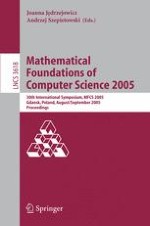2005 | Buch
Mathematical Foundations of Computer Science 2005
30th International Symposium, MFCS 2005, Gdansk, Poland, August 29–September 2, 2005. Proceedings
herausgegeben von: Joanna Jȩdrzejowicz, Andrzej Szepietowski
Verlag: Springer Berlin Heidelberg
Buchreihe : Lecture Notes in Computer Science
